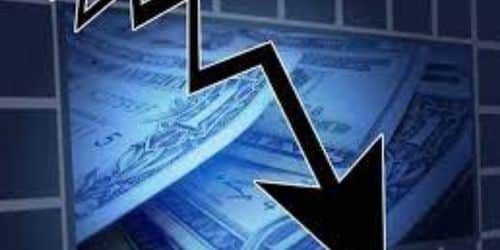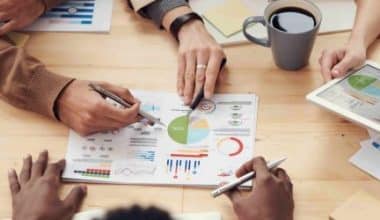Economic activity decreases that are severe, pervasive, and long-lasting are referred to as recessions. Even though more complex calculations are sometimes used, a general rule of thumb is that two consecutive quarters of negative gross domestic product (GDP) growth signal a recession.
What is a Recession
Economic activity decreases that is severe, pervasive, and long-lasting are referred to as recessions. Even though more complex calculations are sometimes used, a general rule of thumb is that two consecutive quarters of negative gross domestic product (GDP) growth signal a recession.
A recession is a time when the economy as a whole is less active. When the GDP growth rate has been negative for two consecutive quarters, a recession is considered to have occurred. What they are is decided by an expert group at the National Bureau of Economic Research (NBER) in the United States (NBER).
What is a recession? Recessions are considered a common occurrence in the expansion and contraction of business and economic cycles. An economy begins to expand when it is in its “trough,” or lowest position; when it is in its “peak,” it begins to contract (highest point). Depression finally results from a protracted, severe recession. The Great Depression of the early 1900s lasted for a number of years, caused a decrease in GDP of more than 10%, and peaked with unemployment rates of 25%.
The Warning Signs of a Recession
#1. Gross Domestic Product (GDP)
Real GDP, which accounts for inflation, quantifies the total value added throughout the production of goods and services in an economy. A real GDP that is below zero indicates a serious decline in productivity.
#2. Real income
Personal income is measured, discounted for social security benefits like welfare payments, and then adjusted for inflation to determine real income. The purchasing power is decreased as a result of a fall in actual income.
#3. Producing
A strong measure of an economy’s health and self-sufficiency is the manufacturing sector’s performance, which accounts for total exports, total imports, and trade deficits (or surpluses) with other nations.
#4. Retail and wholesale
Wholesale and retail sales are also evaluated, and their results are adjusted for inflation, to determine how well an item is performing on the market.
#5. Employment
High unemployment serves as a lagging indicator. Instead of anticipating a recession, it frequently shows that an economy is headed that way. Problematic unemployment rates are often those that are close to 6% of the workforce.
What Caused the Recession?
#1. Real factors
A recession might be sparked by an abrupt shift in structural characteristics or a decline in the external economy. This phenomenon is explained by the real business cycle theory, which holds that a recession results from a rational market participant reacting negatively to unexpected shocks.
For instance, growing geopolitical tensions can result in an unanticipated increase in oil prices that harms nations that depend on the export of crude oil. An innovative technology that results in factory automation may have a disproportionately detrimental effect on nations with large pools of unskilled workers.
#2. monetary and nominal components
Recessions are mostly brought on by excessive credit expansion during expansionary periods, claims the monetarist school of economics. A lack of credit and money supply worsens a downturn in its early phases. For instance, interest rates and the relationships between certain products are actual and monetary factors that are closely related. Since monetary policy tools like interest rates also take institutional reactions to projected slowdowns into account, there is an implied relationship between the two.
Benchmark interest rates are frequently linked to financial indicators of impending recessions. For instance, the Treasury yield curve inverted 18 months before the start of each of the previous seven U.S. financial crises. Reduced expectations for the future are also suggested by a consistent decline in stock prices.
Excessive excitement and overexposure to risky capital are two instances of psychological issues that can arise during an economic upswing. A bubble formed in the US housing market in 2008 as a result of reckless speculation, which at least in part contributed to the onset of the Global Financial Crisis. Another psychological component that can be observed is decreased investment as a result of pervasive market pessimism that has no foundation in the real economy.
#4. consequences of the recession
Among other monetary and fiscal repercussions, recessions frequently result in tighter lending standards and a propensity for falling short-term interest rates. Unemployment rates are rising as businesses try to minimize costs. Consumption decreases as a result, which also lowers inflation. Reduced pricing results in decreased firm earnings, which leads to additional job losses and a downward economic loop.
National governments occasionally step in to save critically vital firms that are in danger of failing or financially fundamentally important institutions like huge banks. Some businesses with foresight and planning are able to profit from a downturn by identifying the implicit opportunity given by the lower cost of capital when interest rates and prices fall. Employers can select from a broader pool of qualified candidates because there are more unemployed people available.
Are We in a Recession
Even if there is still disagreement about the precise semantics of this, the answer seems to be no. There is no recession in the US market. There is considerable agreement that the overall prerequisites for a recession have not been reached, despite the fact that the GDP has fallen for two consecutive quarters.
According to Cardinal Retirement Planning’s chief investment officer, Anessa Custovic, Ph.D., a recession could happen in 2023, but it might just be slight. She thinks that the current job market’s strength will allow us to weather the current recession with little to no damage. Because employment and spending levels have stayed mostly similar despite the US economy’s decline, economists and business executives often do not believe that the US economy fits the criteria for a recession. Because income and spending have a hard time keeping up with inflation, it is challenging to draw a firm conclusion.
Will there be a recession in 2023?
Although the majority of people concur that we are not yet in a recession, there is growing worry that we are. According to a recent KPMG survey, 91% of US CEOs expect a recession within the next 12 months. Those raising the alarm included the CEOs of the biggest investment banks.
For instance, Jamie Dimon, CEO of JP Morgan, frequently speaks about the possibility of a future recession. He claimed in June that there is a 20% to 30% chance of “something worse” and a “harder recession.”
Similar worries were expressed by Goldman Sachs CEO David Solomon during the company’s third-quarter earnings call. He claimed that the performance of Goldman Sachs is being impacted by both rising interest rates and the state of the world. Solomon asserts that there is a “good chance” that the US will go through a recession.
Who decides when a recession has started?
The Business Cycle Committee of the National Bureau of Economic Research makes the determination of whether or not a recession is genuinely occurring. Investigating significant economic topics is the private, impartial NBER. The Business Cycle Committee, in accordance with Custovic, is responsible for identifying the peak, trough, and other periods of the US economic cycle. To determine if a recession has occurred, they employ a set of criteria.
Furthermore, by the time the NBER does declare a recession, we have frequently been in one for at least a few months because the publication of macroeconomic data occasionally lags the time periods for which it is collected.
Recession and Inflation
In talks of the economy, the words “recession” and “inflation” are frequently used. Even if we go through several business cycles, including contraction, peak, growth, and trough, it’s possible that we can’t forecast how each cycle will affect the economy. Although the effects of these two words on economic growth are widely known, the reasons why they occur and how they affect an economy vary. These reasons are explained below.
What is a Recession?
Due to a decline in the gross domestic product for two consecutive quarters, there has been a general decline in economic activity. A recession is characterized by high unemployment rates, low commodity prices, a decline in the value of assets, and weak sales, however, it is less severe than a depression.
What is an Inflation?
This is the gradual rise in the cost of goods and services throughout an economy. As a result, each unit of currency can buy fewer goods and services, devaluing the currency. High inflation is an indication of an overheated economy, notwithstanding experts’ claims that moderate inflation is good for the economy.
When an economy expands and there is a corresponding increase in demand for goods and services, inflation results. Because of this, there is a surplus of demand relative to supply, which drives up prices.
Comparison Between Inflation and Recession
- They both influence economic activity.
- Both are brought on by negative economic results.
Recession and Inflation Differences
Definition
When the gross domestic product declines for two consecutive quarters, it results in a general decline in economic activity, which is referred to as a recession. On the other hand, inflation describes an increase in a country’s economy’s price of products and services over time.
Measure
Inflation is evaluated by the Wholesale Price Index (WPI) and the Consumer Price Index, whereas a recession is determined by Gross Domestic Product (CPI).
Period
While a recession only happens under specific economic circumstances, inflation happens continuously in an economy.
Recession Example
To better comprehend the notion, let’s look at the examples of economic recessions below:
The first example of recession: Kent Brothers, one of the key participants in the US banking industry, went out of business as a result of the financial crisis of 2010. As a result, subprime lending decreased nationwide, which decreased bank liquidity. For the banks and financial institutions, who gave permissive loans to people without performing any financial checks, the expansion of credit was exponential. As a result, there were more defaults, which led to the credits becoming non-performing assets and reduced liquidity.
Example 2: There were indications of an economic turndown in 2022. Additionally, it appears that the conflict between Russia and Ukraine is raising interest rates, reducing economic development, and portending a US economic downturn.
The price of government bonds has been inverting on the US market. Market since the war’s beginning. Although economists do not predict a recession, previous recessions have been greatly influenced by the inversion that has been witnessed. This in turn suggests that a future recession might be on the horizon.
Recession in the US
According to the NBER, recessions have typically lasted somewhere between two months and many years. However, the particularities of our current economic situation make it challenging to directly compare it to earlier occasions. The pandemic’s ongoing impacts remain a huge unknown, especially in terms of inventory and supply chain disruptions. Although the unemployment rate is still low, each week we hear more discussion of job cuts and reduced corporate expenses. Another issue is the conflict in Ukraine.
Since economic cycles are often unpredictable, it is vital to have a solid financial foundation. Although the economy has faltered on occasion in 2022, it has undoubtedly been resilient, and by conventional standards, the United States is not now in a recession. A recession has traditionally been defined as two consecutive quarters with a typically weakening economy.
Will 2023 be a recession?
In 2023, the possibility of a U.S. recession still exists. According to Goldman Sachs Research, the probability of a significant decline in the American economy over the next 12 months is estimated by the market to be 65%. But according to our own economic study, the likelihood is substantially smaller, at 35%.
What to do during a recession?
- Identify your top financial priorities.
- If you can, concentrate on paying off your debt.
- Think about the possibilities for your career, both now and in the future.
- Try to increase your emergency savings in advance.
- Maintaining awareness of your financial status is important.
What happens if a recession hits?
In a recession, economic output, jobs, and consumer spending all decline. As the central bank lowers rates to support the economy (like the U.S. Federal Reserve Bank), interest rates are also likely to decrease.
Where do you put money during a recession?
Some investments tend to do better than others during recessions, however, no investment can be guaranteed to be recession-proof. These include large-cap stocks, income investments, consumer staples, and healthcare companies.
Do you need cash in a recession?
Additionally, during a recession, having cash on hand is essential in case of job loss or other income reduction. Your money will earn more in a savings account as rates climb.
Who gets hurt in a recession?
“A major fall in economic activity distributed across the economy, lasting more than a few months,” is the definition of a recession. Retail, restaurants, travel/tourism, leisure/hospitality, service providers, real estate, and manufacturing/warehouse are the industries most impacted.
Recession FAQs
Will 2023 be a recession?
In 2023, the possibility of a U.S. recession still exists.
What happens if a recession hits?
In a recession, economic output, jobs, and consumer spending all decline. As the central bank lowers rates to support the economy (like the U.S. Federal Reserve Bank), interest rates are also likely to decrease.
References
- corporatefinanceinstitute.com
- businessinsider.com
- differencebetween.net
- wallstreetmojo.com
- nerdwallet.com






